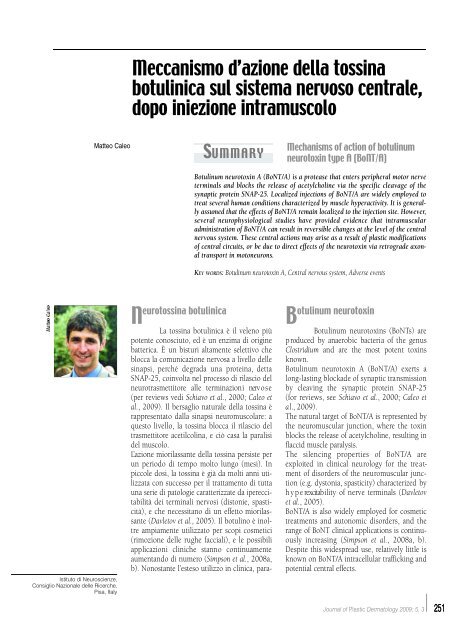Vol. 5, n. 3, September-December 2009 - Salute per tutti
Vol. 5, n. 3, September-December 2009 - Salute per tutti
Vol. 5, n. 3, September-December 2009 - Salute per tutti
You also want an ePaper? Increase the reach of your titles
YUMPU automatically turns print PDFs into web optimized ePapers that Google loves.
Meccanismo d’azione della tossina<br />
botulinica sul sistema nervoso centrale,<br />
dopo iniezione intramuscolo<br />
Matteo Caleo<br />
SU M M A R Y<br />
Mechanisms of action of botulinum<br />
neurotoxin type A (BoNT/A)<br />
Botulinum neurotoxin A (BoNT/A) is a protease that enters <strong>per</strong>ipheral motor nerve<br />
terminals and blocks the release of acetylcholine via the specific cleavage of the<br />
synaptic protein SNAP-25. Localized injections of BoNT/A are widely employed to<br />
treat several human conditions characterized by muscle hy<strong>per</strong>activity. It is generally<br />
assumed that the effects of BoNT/A remain localized to the injection site. However,<br />
several neurophysiological studies have provided evidence that intramuscular<br />
administration of BoNT/A can result in reversible changes at the level of the central<br />
nervous system. These central actions may arise as a result of plastic modifications<br />
of central circuits, or be due to direct effects of the neurotoxin via retrograde axonal<br />
transport in motoneurons.<br />
KE Y W O R D S: Botulinum neurotoxin A, Central nervous system, Adverse events<br />
Istituto di Neuroscienze,<br />
Consiglio Nazionale delle Ricerche,<br />
Pisa, Italy<br />
eurotossina botulinica<br />
N<br />
La tossina botulinica è il veleno più<br />
potente conosciuto, ed è un enzima di origine<br />
batterica. È un bisturi altamente selettivo che<br />
blocca la comunicazione nervosa a livello delle<br />
sinapsi, <strong>per</strong>ché degrada una proteina, detta<br />
SNAP-25, coinvolta nel processo di rilascio del<br />
n e u ro t r a s m e t t i t o re alle terminazioni nerv o s e<br />
(<strong>per</strong> reviews vedi Schiavo et al., 2000; Caleo et<br />
al., <strong>2009</strong>). Il bersaglio naturale della tossina è<br />
rappresentato dalla sinapsi neuromuscolare: a<br />
questo livello, la tossina blocca il rilascio del<br />
trasmettitore acetilcolina, e ciò casa la paralisi<br />
del muscolo.<br />
L’azione miorilassante della tossina <strong>per</strong>siste <strong>per</strong><br />
un <strong>per</strong>iodo di tempo molto lungo (mesi). In<br />
piccole dosi, la tossina è già da molti anni utilizzata<br />
con successo <strong>per</strong> il trattamento di tutta<br />
una serie di patologie caratterizzate da i<strong>per</strong>eccitabilità<br />
dei terminali nervosi (distonie, spasticità),<br />
e che necessitano di un effetto miorilassante<br />
(Davletov et al., 2005). Il botulino è inoltre<br />
ampiamente utilizzato <strong>per</strong> scopi cosmetici<br />
(rimozione delle rughe facciali), e le possibili<br />
applicazioni cliniche stanno continuamente<br />
aumentando di numero (Simpson et al., 2008a,<br />
b). Nonostante l’esteso utilizzo in clinica, para-<br />
otulinum neurotoxin<br />
B<br />
Botulinum neurotoxins (BoNTs) are<br />
p roduced by anaerobic bacteria of the genus<br />
C l o s t r i d i u m and are the most potent toxins<br />
known.<br />
Botulinum neurotoxin A (BoNT/A) exerts a<br />
long-lasting blockade of synaptic transmission<br />
by cleaving the synaptic protein SNAP-25<br />
( f o r reviews, see Schiavo et al., 2000; Caleo et<br />
a l ., <strong>2009</strong>).<br />
The natural target of BoNT/A is represented by<br />
the neuromuscular junction, where the toxin<br />
blocks the release of acetylcholine, resulting in<br />
flaccid muscle paralysis.<br />
The silencing pro<strong>per</strong>ties of BoNT/A are<br />
exploited in clinical neurology for the tre a t-<br />
ment of disorders of the neuromuscular junction<br />
(e.g. dystonia, spasticity) characterized by<br />
h y p e rexcitability of nerve terminals (D a v l e t o v<br />
et al., 2005).<br />
BoNT/A is also widely employed for cosmetic<br />
treatments and autonomic disorders, and the<br />
range of BoNT clinical applications is continuously<br />
increasing (Simpson et al., 2008a, b).<br />
Despite this widespread use, relatively little is<br />
known on BoNT/A intracellular trafficking and<br />
potential central effects.<br />
Journal of Plastic Dermatology <strong>2009</strong>; 5, 3 251

















